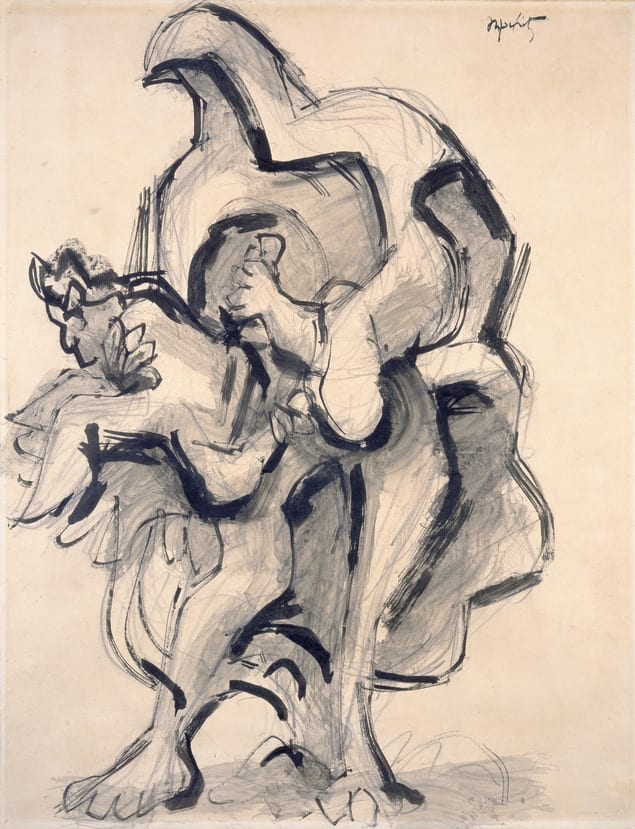
- Artist/Maker:
- Jacques Lipchitz
- Bio:
- American and French, b. Lithuania, 1891-1973
- Title:
- Sketch for "Sacrifice"
- Date:
- 1946
- Medium:
- Ink and and ink wash on paper
- Dimensions:
- 22 × 17 in. (55.9 × 43.2 cm)
- Credit Line:
- Gift of Janet Laib Gottlieb
- Accession Number:
- 1994-713
Not On View
Lipchitz worked with mythological themes from the 1920s. During the thirties, mirroring the contemporary political situation, his subjects became more violent and included rapes and combats. Prometheus (the benefactor of mankind) strangling the vulture (the Titan's tormentor) had special significance for Lipchitz during the time of the Spanish Civil War. A wash drawing of this theme was reproduced a decade later on the cover of Lipchitz's exhibition at Galerie Maeght in Paris in 1946. The theme of "Sacrifice," however, refers more closely to Judaic tradition.
During his exile in America in the 1940s, Lipchitz was very concerned with the fate of European jewry. According to Henry Hope, "while brooding over the mass tragedy of the Jews in Europe, Lipchitz conceived the Prayer (1943)": for Alan Wilkinson, this sculpture represents, "Lipchitz's most anguished reaction to the fate of the Jews in Europe." In "Prayer," the expiation is conducted by a figure in a prayer shawl (tallith). The ritual is associated with "Kaparot," an atonement whereby sins are transferred to the cock which is slaughtered and offered to the poor on the eve of Yom Kippur. The theme of "Sacrifice," according to the artist, was, "much heavier and forceful, even fierce, in concept." Contrary to ritual practice, the act is accomplished with a dagger, to "heighten the drama." The sculptor reflected in his biography on the "anger" in the choice of theme--a subject treated in at least four related drawings, three plasters, and six bronzes. The directly related plaster (Otterlo) and bronze (Philadelphia) are both dated 1947. Lipchitz's design--which is close to the earliest conceptions of the motif in showing the knife borne by the left hand of the officiate--was reproduced in Partisan Review in 1948, facing an editorial which makes reference to Picasso's "Guernica" (1937) as an attack on dictatorship.
During his exile in America in the 1940s, Lipchitz was very concerned with the fate of European jewry. According to Henry Hope, "while brooding over the mass tragedy of the Jews in Europe, Lipchitz conceived the Prayer (1943)": for Alan Wilkinson, this sculpture represents, "Lipchitz's most anguished reaction to the fate of the Jews in Europe." In "Prayer," the expiation is conducted by a figure in a prayer shawl (tallith). The ritual is associated with "Kaparot," an atonement whereby sins are transferred to the cock which is slaughtered and offered to the poor on the eve of Yom Kippur. The theme of "Sacrifice," according to the artist, was, "much heavier and forceful, even fierce, in concept." Contrary to ritual practice, the act is accomplished with a dagger, to "heighten the drama." The sculptor reflected in his biography on the "anger" in the choice of theme--a subject treated in at least four related drawings, three plasters, and six bronzes. The directly related plaster (Otterlo) and bronze (Philadelphia) are both dated 1947. Lipchitz's design--which is close to the earliest conceptions of the motif in showing the knife borne by the left hand of the officiate--was reproduced in Partisan Review in 1948, facing an editorial which makes reference to Picasso's "Guernica" (1937) as an attack on dictatorship.
Information may change as a result of ongoing research.